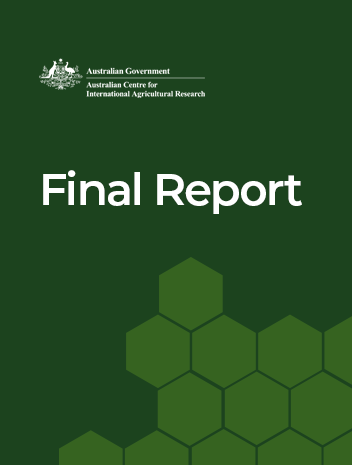- HomeHome
-
About ACIAR
- Our work
- Our people
-
Corporate information
- ACIAR Audit Committee
- Commission for International Agricultural Research
- Policy Advisory Council
- Agency reviews
- Executive remuneration disclosure
- Freedom of information (FOI)
- Gifts and benefits register
- Information publication scheme
- List of new agency files
- Contracts
- Legal services expenditure
- Privacy impact assessment register
- Commonwealth Child Safe Framework
- Benefits to Australia
- Careers
- 40 years of ACIAR
-
What we do
- Programs
- Cross-cutting areas
- Resources
- Where we work
-
Funding
- Research projects
- Fellowships
-
Scholarships
- John Allwright FellowshipScholarships to study in Australia for ACIAR partner country scientists to have Australian postgraduate qualifications
- ACIAR Pacific Agriculture Scholarships and Support and Climate Resilience Program
- Alumni Research Support Facility
- Publications
- News and Outreach
Project final report
Economic analysis of policies affecting pulses in Pakistan - final report
Date released
01 June 2019
ISBN
978-1-925747-59-1
Publication Code
ADP/2016/043
Overview
This project aimed to provide policy-makers with evidence-based economic analysis and advice so they can reduce constraints to pulses production and trade, and increase productivity in Pakistan.
Pulses are dried seeds of the legume family (including chickpeas, mung beans, lentils and mash beans) and are an important source of vegetable protein in Pakistan. International and domestic demand for pulses is expected to grow, but production has stagnated in recent years. Production and prices are volatile, and post-harvest losses are significant.
ACIAR is implementing a large project (CIM/2015/041) to increase productivity and profitability in the pulses sector. Biological/agronomic research into pulses is laudable, but inappropriate policies and insufficient understanding of the market may limit productivity and profitability.
Publically available information and analysis of the pulses industry and related policy is limited.
The SRA:
- reviewed policies and programs that affect pulses production and trade in Pakistan;
- identified the constraints and barriers to further pulses production and consumption, including financial viability of pulses and competing crops;
- analysed how Government policies affect pulses prices and producer profitability; and
- advised Pakistani policy-makers on policy reform to increase pulses production and trade.
Poor farmers will benefit from changed policies potentially resulting in increased pulses profitability, diversity, more efficient resource-allocation and competitive markets, and hence higher and more stable incomes, while consumers will have cheaper, more diverse and better quality food.



